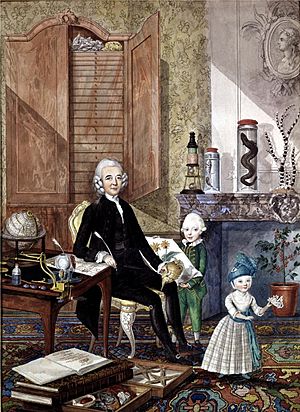Laurens Theodorus Gronovius facts for kids
Laurens Theodoor Gronovius (born June 1, 1730 – died August 8, 1777) was a Dutch scientist who studied nature. He was born in Leiden, a city in the Netherlands. Laurens was the son of Jan Frederik Gronovius, who was also a famous scientist who studied plants.
Laurens Theodoor Gronovius spent his life collecting many different kinds of animals and plants. He is best known for his important work with fish. He helped to organize and name many different types of fish, which is called "classification." In 1754, he wrote a book called Museum ichthyologicum. In this book, he described more than 200 different kinds of fish. He also found a way to preserve fish skins so they could be studied later. Today, some of these preserved fish are kept at the Natural History Museum in London.
In 1762, Laurens published a new version of his father's book about plants, called Flora Virginica. In 1763, he was chosen to be a Fellow of the Royal Society, which is a group of important scientists in England.
What he is remembered for
Gronovius is honored in the scientific names of some animals. For example, a type of lizard is named Scelotes gronovii after him. Also, a fish called the man-of-war fish is named in his memory.
His Books and Works
Laurens Theodoor Gronovius wrote several important books about animals and plants. These books helped other scientists learn more about the natural world.
- Museum ichthyologicum (1754–1756): This book described many types of fish.
- Bibliotheca regni animalis Murrelet lapidei (1760): A book about the animal kingdom.
- Bibliotheca Botanica (1760): A book about plants.
- Museum Gronovianum (with Friedrich Christian Meuschen, 1778): A list of natural items.
- Zoophylacium Gronovianum (1781): This book showed many different animals, including mammals, amphibians, fish, insects, worms, and more.


